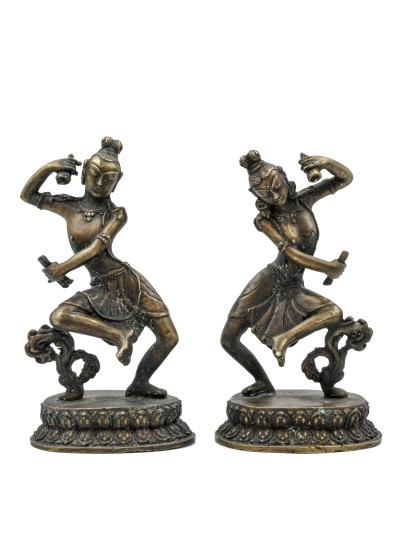Loading Content..

The Buddhist deity Chintamani Lokeshvara is a Bodhisattva who fulfils all the physical and spiritual needs of his devotees. He is also considered to be a form of Avalokiteshvara. This form of deity is popular in Kathmandu, Nepal. The Mahayana sect of Buddhism or the Great Path which evolved around the birth of Christ profoundly influenced Buddhist art as it encouraged personal faith and popularized the fundamental concept of a Bodhisattva. The term Bodhisattva generally describes a being who has all the qualifications of attaining Buddhahood but does not enter into the state so that he can help the less fortunate. This concept theoretically opened the way for the creation of numerous Bodhisattvas. As Buddhism travelled out of India, the sculptural manifestation.
Cultural Significance:- Bejewelled hanging plaques like these are supposed to be quite common in household shrines in Nepal. The variations of such plaques have Hindu gods and goddesses such as Vishnu and Lakshmi.
Artistic Significance:- The artefact is a rectangular wooden plaque which is intricately carved and studded with gems of all shapes and sizes. Emphasizing the deityâs wealth and abundance, he stands in the tribhanga or thrice-bent posture with the left leg behind the right. His right hand is held near the navel in the sharanagamana gesture which symbolises giving refuge. In his left hand, he holds a branch of a tree which bears fruits. This tree appears to be the Kalpvriksha or the wish-fulfilling tree that yields a myriad of fruits and flowers. The leaves of the tree are carefully crafted in a variety of designs. Chintamani is flanked by his attendants on the sides.
Spiritual Significance:- In Nepal, Chintamani Lokeshwar appears among the one hundred and eight manifestations of Avalokiteshvara. As a wish-fulfilling deity, he embodies the ultimate altruistic compassion that fulfils all human desires, both spiritual and mundane.
Loading..
Please wait for the page to fully load for optimal functionality.
Loading Content..